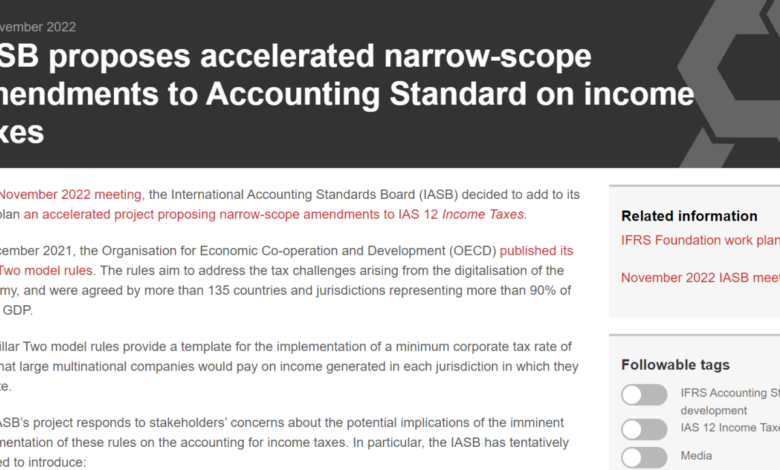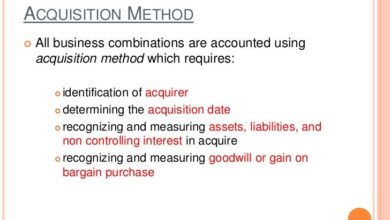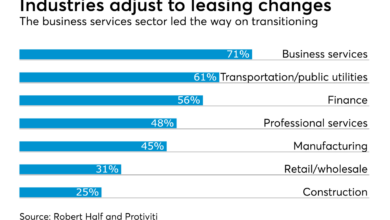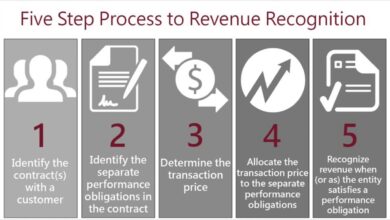
IASB Standard Amendments Ibor Reform Response
IASB standard amendments in response to Ibor reform are reshaping financial reporting practices globally. These changes, driven by the need for clarity and consistency, will significantly impact how companies report financial instruments, requiring adjustments in internal processes and potentially altering valuations. Understanding the details of these amendments is crucial for navigating the evolving financial landscape.
This comprehensive overview delves into the specifics of the amendments, examining their rationale, key changes, practical implications, and the international context. We’ll explore the transition period, potential challenges, and emerging trends, all while providing illustrative examples to clarify the impact on various financial instruments and reporting.
IASB Standard Amendments in Response to IBOR Reform

The International Accounting Standards Board (IASB) has been actively responding to the changing financial landscape, particularly the discontinuation of various Interbank Offered Rates (IBORs). This reform has significant implications for financial reporting, necessitating adjustments to accounting standards to ensure consistency and comparability of financial information. The IASB’s amendments aim to address these challenges and maintain the integrity of financial statements.The rationale behind these amendments is to provide businesses with clear guidance and consistent accounting practices in the face of evolving interest rate benchmarks.
This clarity is crucial for investors and stakeholders to make informed decisions, as the shift from IBORs impacts various financial instruments and transactions. The amendments also reflect the need for robust and reliable accounting during a period of significant market change.
Summary of Amendments
The IASB amendments address the transition from IBORs to alternative reference rates. This transition impacts various accounting standards related to financial instruments, such as loans, debt securities, and derivatives. These adjustments are vital to maintaining the consistency and reliability of financial reporting in the post-IBOR era.
Key Changes Introduced
The amendments introduce crucial adjustments to accounting standards, ensuring the accurate reflection of financial instruments’ values in financial statements. This includes provisions for recognizing and measuring the impact of alternative reference rates on financial assets and liabilities. Key adjustments are centered around:
- Recognition and Measurement of Financial Instruments: The amendments provide detailed guidance on how to recognize and measure financial instruments impacted by the IBOR transition. This encompasses various types of instruments, including loans, debt securities, and derivatives.
- Transition Provisions: The amendments include clear transition provisions to facilitate a smooth transition for businesses. These provisions address the accounting treatment of existing financial instruments during the changeover period.
- Disclosure Requirements: The amendments introduce specific disclosure requirements to ensure transparency and clarity regarding the impact of the IBOR reform on financial statements. This includes details about the alternative reference rates used, any adjustments made, and the impact on the financial position and performance of the entity.
Amendment Table
This table summarizes the IASB standard amendments in response to IBOR reform, detailing the standard number, amendment description, and effective date.
| Standard Number | Amendment Description | Effective Date |
|---|---|---|
| IAS 39 (Financial Instruments: Recognition and Measurement) | Amendments to address the transition from IBORs to alternative reference rates, including provisions for recognition and measurement of financial instruments. | 2023 |
| IFRS 9 (Financial Instruments) | Amendments that adjust the requirements for recognizing and measuring financial assets and liabilities, encompassing the impacts of alternative reference rates. | 2023 |
| IFRS 7 (Financial Instruments: Disclosures) | Amendments focusing on specific disclosure requirements for financial instruments impacted by the IBOR reform. | 2023 |
Impact on Financial Reporting
The IASB’s amendments in response to IBOR reform represent a significant shift in how financial institutions report interest rate-sensitive instruments. These changes aim to enhance the transparency and comparability of financial statements, particularly in a post-IBOR world where alternative reference rates are now in use. The impact spans various aspects of financial reporting, requiring adjustments in accounting policies, disclosures, and calculations.The amendments will mandate adjustments to existing financial reporting practices.
This includes changes to how interest rate risk is measured and reported, as well as modifications to the valuation and presentation of financial instruments. These adjustments are necessary to reflect the evolving market landscape and ensure consistent and reliable financial reporting across different entities.
Impact on Interest Rate-Sensitive Financial Instruments
The amendments directly affect instruments whose value is tied to interest rates, such as loans, bonds, and derivatives. These instruments will require recalibration of their carrying amounts, and the disclosures will reflect the new reference rates used. For example, if a company has a loan that was previously benchmarked to LIBOR, it will need to re-evaluate its value using a new alternative reference rate, such as SOFR (Secured Overnight Financing Rate).
The impact on the balance sheet and income statement will vary depending on the specific instrument and the alternative rate selected.
Comparison of Reporting Requirements
The pre-amendment reporting focused on LIBOR as the primary reference rate. The post-amendment reporting will require the use of alternative reference rates, along with specific disclosures about the impact of the transition. The amendments will demand more detailed disclosures about the specific alternative rate used, the methodology applied for valuation, and the assumptions made. This transition period will involve significant work to adapt systems and processes for financial reporting.
Disclosure Differences in Financial Statements
| Disclosure Item | Pre-Amendment | Post-Amendment |
|---|---|---|
| Interest Rate Risk | General description of interest rate risk exposure. | Specific details on the alternative reference rate used for valuation, sensitivity analysis, and potential impact on earnings. |
| Financial Instruments | Valuation based on LIBOR. Limited disclosures on the methodology. | Valuation based on the chosen alternative reference rate. Detailed methodology for valuation, and any significant assumptions made. |
| Fair Value Measurement | Limited disclosure of fair value measurement methodologies. | Comprehensive disclosure of fair value measurement methodologies, including the alternative rate used, any changes in assumptions, and the impact on carrying amounts. |
| Transition Costs | Not specifically addressed. | Potential disclosure of transition costs related to the change in reference rates. |
The table above illustrates the key differences in disclosures required before and after the amendments. The post-amendment disclosures will provide a more comprehensive picture of the financial instrument’s valuation and the impact of the transition from LIBOR to alternative rates. This increased transparency is critical for investors and other stakeholders in assessing the financial health and risk profiles of companies.
Practical Implications for Businesses
The IASB’s amendments in response to IBOR reform represent a significant shift for businesses reliant on these benchmarks. Navigating these changes requires careful consideration of internal processes, financial reporting, and potential costs and benefits. This necessitates a proactive approach to ensure compliance and maintain financial stability.
Impact on Financial Instruments
The amendments directly impact financial instruments, particularly those tied to IBOR rates. Companies will need to reassess contracts, loans, and other agreements referencing IBOR. This involves identifying the specific IBOR rates used in contracts and determining the appropriate replacement rates. Furthermore, companies must update their valuation models and accounting policies to reflect the new benchmarks. A crucial aspect is the identification of any potential exposure to rate differences between the old IBOR and the replacement rates, as this will have significant implications for future financial reporting.
You also can understand valuable knowledge by exploring global cfo survey rebuild revenue streams.
The complexity of this task varies based on the volume and types of contracts held by each company.
Adjusting Internal Processes
Implementing the changes requires a comprehensive review and adjustment of internal processes. Companies should establish clear procedures for identifying IBOR-linked instruments. They should also develop methods for calculating the new reference rates and for incorporating them into financial reporting. Specific steps may include creating a dedicated team or department to manage the transition, training staff on new accounting policies, and updating software systems.
This meticulous approach ensures accurate and timely financial reporting.
Potential Costs and Benefits, Iasb standard amendments in response to ibor reform
The transition to the new benchmarks may involve costs, such as retraining staff, updating software, and consulting fees. However, potential benefits include improved accuracy in financial reporting, reduced risk associated with IBOR-linked contracts, and enhanced compliance with regulatory requirements. The benefits of adhering to the revised standards outweigh the associated costs in the long run, by ensuring compliance and reducing potential legal or financial penalties.
Companies can expect to see long-term benefits in their financial reporting and operational efficiency.
Steps for Business Preparation
- Assessment of IBOR Exposure: Thoroughly analyze all contracts, loans, and other agreements to identify all instances where IBOR is used. This detailed inventory is crucial for a well-planned transition. Documentation of all IBOR-linked instruments is essential for accurate assessment.
- Selection of Replacement Rates: Choose appropriate replacement rates for each IBOR type, considering factors like the contract terms and the specific financial instrument. The selected replacement rates should reflect the current market conditions accurately. Consulting with financial experts and legal professionals is recommended to ensure compliance and appropriateness.
- Update Valuation Models: Review and adjust internal valuation models to incorporate the new reference rates. Accurate valuation is paramount for accurate financial reporting. The models must reflect the current market conditions to ensure financial reporting reliability.
- Internal Training: Provide comprehensive training to relevant personnel on the new accounting standards and procedures. Ensuring all personnel understand the changes is crucial for successful implementation.
- Documentation and Reporting: Maintain meticulous records of all changes made and the rationale behind them. This thorough documentation is critical for audit trails and regulatory compliance. Regular reporting of progress and compliance is also essential.
Transition Period and Implementation

The IASB’s amendments in response to IBOR reform are crucial for maintaining financial reporting accuracy and comparability. A smooth transition is paramount to avoid disrupting business operations and ensuring investors have reliable information. This section details the transition period, provided guidance, potential challenges, and a roadmap for implementation.
Transition Period
The IASB has meticulously designed a transition period to allow businesses to adapt to the new standards. This period offers a structured timeframe for implementation, minimizing disruptions and ensuring a gradual adjustment to the new requirements. The specific duration of this transition period varies depending on the nature of the financial instrument and the reporting entity’s circumstances. This enables entities to adequately assess and implement the necessary changes without compromising existing operations.
Specific Guidance for Transition
The IASB provides comprehensive guidance to help businesses navigate the transition process. This guidance encompasses various aspects, from the identification of affected financial instruments to the calculation of the impact on financial statements. It Artikels methodologies for applying the new standards, offering practical examples and illustrative scenarios to aid in understanding and application. Clear instructions for preparing disclosures and documentation are also included to ensure transparency and compliance.
Potential Challenges During Transition
Implementing these amendments may present challenges. One key challenge is data migration and reconciliation. Businesses need to ensure the accuracy of historical data and its alignment with the new standards. Another challenge is the need for training and upskilling staff to handle the revised processes and calculations. Lastly, the complexity of some provisions might require specialized expertise to interpret and apply the new rules effectively.
Examples include large multinational companies with complex financial structures and intricate accounting practices.
Key Steps in Implementing Amendments
A structured approach to implementation is essential. The flowchart below Artikels the crucial steps involved, highlighting the importance of careful planning and execution.
| Step | Description |
|---|---|
| 1. Assessment and Planning | Thoroughly review the impact of the amendments on the business’s financial reporting. Identify affected instruments and related financial statements. Establish a timeline for implementation. |
| 2. Data Collection and Validation | Gather historical data on affected instruments. Validate the accuracy and completeness of the data. Prepare for data migration to align with the new standards. |
| 3. Staff Training and Support | Provide training to staff members on the new standards and their application. Establish internal support mechanisms to address any queries or challenges during the transition. |
| 4. System Updates and Modifications | Update accounting systems and processes to accommodate the new requirements. Develop new templates and reporting procedures for the updated financial instruments. |
| 5. Implementation and Testing | Apply the new standards to existing and future financial instruments. Rigorously test the implementation process to identify and rectify any potential errors. |
| 6. Reporting and Disclosure | Prepare financial statements and disclosures in accordance with the amended standards. Ensure compliance with reporting requirements. |
International Perspective
The IASB’s amendments to accounting standards in response to Ibor reform have significant international implications, potentially impacting financial reporting practices worldwide. Understanding these implications is crucial for businesses operating across borders, as well as for investors and regulators globally. These changes will affect how various jurisdictions report financial data, requiring careful consideration of differing interpretations and implementations.The adoption and interpretation of these amendments will likely vary across different jurisdictions.
These variations could stem from differences in legal frameworks, regulatory requirements, and national accounting standards. Understanding these differences is essential for navigating the complexities of global financial reporting.
International Implications of the Amendments
The IASB amendments aim to provide a consistent and globally applicable framework for financial reporting, but practical implementation may vary significantly. This variance is likely to be evident in the treatment of specific instruments, calculations, and disclosures. The need for harmonization is critical to maintain the comparability of financial information on a global scale.
Potential Differences in Implementation Across Jurisdictions
Differences in national accounting standards and regulatory frameworks can lead to variations in the implementation of the IASB’s amendments. For instance, jurisdictions with different legal structures may adopt different approaches to specific accounting treatments. This could result in varied interpretations of the amendments, requiring careful consideration for businesses operating internationally.
Discover more by delving into finance departments evolving while bracing for coronavirus second wave further.
- Legal Frameworks: Jurisdictions with different legal systems may interpret contractual obligations and accounting treatments differently. This can lead to varied approaches in the application of the amendments.
- Regulatory Requirements: National regulations may mandate specific disclosures or treatments not explicitly addressed in the IASB amendments. This necessitates a thorough understanding of local requirements.
- National Accounting Standards: The interaction between IASB standards and national accounting standards will determine the specific implementation of the amendments in different jurisdictions. This interaction can introduce complexities and potential differences.
Comparison of IASB’s Approach with Other Accounting Standards Bodies
A comparative analysis of the IASB’s approach to Ibor reform with other accounting standards bodies (e.g., US GAAP) reveals nuanced differences in the detailed treatment of specific issues. These differences could be due to varying priorities and perspectives on the financial reporting implications of the reform.
Global Impact on Financial Reporting Standards
The amendments are expected to have a significant global impact on financial reporting standards. The need for global harmonization of financial reporting standards is crucial for facilitating international investment and trade. The changes will require businesses to adjust their financial reporting practices to comply with the new standards, which may lead to significant operational and reporting costs. The overall impact will depend on how effectively different jurisdictions implement the amendments.
This could lead to potential challenges in global financial reporting consistency and comparability.
Emerging Trends and Future Considerations
The International Accounting Standards Board’s (IASB) amendments in response to IBOR reform represent a significant step towards a more robust and transparent financial reporting landscape. However, the evolving financial world demands a proactive approach to anticipate future challenges and opportunities. This section explores potential future developments, identifies areas needing further clarification, and assesses the long-term impact of these amendments.The ongoing digital transformation of financial markets and the rise of alternative benchmarks will likely impact how businesses calculate and report interest rates.
The amendments already reflect the transition from LIBOR, but further evolution in the marketplace necessitates careful monitoring. This includes considering the potential for new, complex financial instruments and the need for accounting standards to adapt to their unique characteristics.
Potential Future Developments in Interest Rate Benchmarks
The shift away from LIBOR is just the beginning of a broader evolution in interest rate benchmarks. Alternative benchmarks, such as SOFR (Secured Overnight Financing Rate), are gaining prominence, and the use of hybrid benchmarks or composite measures is a possibility. The rise of these alternative benchmarks will require a deep understanding of their characteristics, including their calculation methods and underlying market data.
This understanding is crucial for consistent and comparable financial reporting. Understanding the strengths and weaknesses of different benchmarks is crucial.
Gaps in Current Amendments and Areas Requiring Clarification
While the IASB amendments address the immediate need to replace LIBOR, some gaps may emerge as alternative benchmarks evolve. Potential areas needing further clarification include the treatment of complex financial instruments that utilize alternative benchmarks, and the implications for derivative contracts linked to these benchmarks. The potential use of different benchmarks for different types of transactions, such as loans and derivatives, might necessitate more detailed guidance to maintain consistent reporting practices.
Browse the multiple elements of how to clearly communicate feedback and expectations to gain a more broad understanding.
Potential Long-Term Implications of the Amendments
The long-term implications of these amendments extend beyond simply replacing LIBOR. The shift to alternative benchmarks necessitates a fundamental re-evaluation of financial risk management strategies, especially for businesses with significant interest rate exposure. Businesses need to adapt their risk assessment procedures to align with the new benchmarks and potentially adjust their hedging strategies.
Examples of Future Regulatory Impacts on Financial Reporting
The adoption of new accounting standards might affect different industries in varying ways. For example, banks might need to adjust their loan portfolio valuation methods to reflect the new benchmarks, potentially affecting their reported profits. Similarly, companies with significant derivative contracts tied to LIBOR will need to recalculate their exposures and reporting under the new accounting standards. Further, changes in the regulatory landscape related to the use of alternative benchmarks could lead to future updates in accounting standards, demanding a proactive approach from financial reporting stakeholders.
Potential for New Accounting Standards
The emergence of new benchmarks and financial instruments may necessitate the development of entirely new accounting standards in the future. The accounting treatment for newly introduced instruments will require careful consideration and robust frameworks to ensure consistency and comparability. The IASB will likely need to remain vigilant in identifying emerging trends and adapting the standards accordingly to maintain the integrity of financial reporting.
Illustrative Examples of Impact: Iasb Standard Amendments In Response To Ibor Reform
The IASB’s amendments to accounting standards in response to IBOR reform represent a significant shift in how businesses will report interest-related items. These changes are designed to ensure consistency and comparability across financial statements, especially in a world where benchmark rates are evolving. Understanding the practical implications is crucial for accurate financial reporting and strategic decision-making.
Impact on Interest Expense Calculation
The amendments necessitate a recalculation of interest expense for financial instruments, specifically those linked to IBOR. Previously, interest expense might have been calculated using the prevailing IBOR rate, but the new standards mandate the use of alternative reference rates. This change directly affects the reported interest expense on the income statement, as the new rate will inevitably differ from the old one.
Example: Calculating Interest Expense
Consider a company with a floating-rate loan of $10 million linked to the LIBOR 3-month rate. Before the amendments, the interest expense was calculated based on LIBOR plus a spread. Suppose LIBOR was 5% and the spread was 1%. The interest expense for the period would be $550,000. Post-amendments, the loan is recalculated using a comparable risk-free rate.
Let’s say the alternative reference rate is 4.5%. The interest expense for the period will now be $450,000. This difference is a direct consequence of the amendment, highlighting the need for accurate calculation and disclosure of the change.
Impact on Financial Statements
This change necessitates adjustments in both the balance sheet and income statement. The following table illustrates the before-and-after impact:
| Financial Statement Item | Before Amendments | After Amendments |
|---|---|---|
| Interest Expense | $550,000 | $450,000 |
| Interest Payable | $500,000 | $400,000 |
| Loan Amount | $10,000,000 | $10,000,000 |
The table clearly shows the difference in interest expense and payable. The loan amount remains the same, while interest expense and payable are adjusted to reflect the new reference rate.
Impact on Financial Asset and Liability Valuation
The amendments may influence the valuation of financial assets and liabilities, as the new reference rates used for discounting future cash flows may result in different present values. For example, if a company holds a bond whose interest payments are tied to LIBOR, the present value calculation will change when the new reference rate is used. This will affect the carrying amount of the asset or liability on the balance sheet, potentially leading to a revaluation of the asset.
Closure
In conclusion, the IASB’s amendments in response to Ibor reform represent a significant evolution in financial reporting. These changes, while complex, are crucial for maintaining global financial transparency and stability. Understanding the implications of these amendments is vital for businesses operating in a dynamic international market. Navigating the transition period and adapting internal processes will be key to successful implementation.





